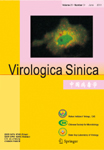-
Barteling S J, Vreeswijk J. 1991. Developments in foot-and-mouth disease vaccines. Vaccine, 9 (2): 75-88.
doi: 10.1016/0264-410X(91)90261-4
-
Beck E, Strohmaier K. 1987. Subtyping of European foot-and-mouth disease virus strains by nucleotide sequence determination. J Virol, 61: 1621-1629.
-
Blanco E, Garcia-Briones M, Sanz-Parra A, et al. 2001. Identification of T-cell epitopes in nonstructural proteins of foot-and-mouth disease virus. J Virol, 75 (7): 3164-3174.
doi: 10.1128/JVI.75.7.3164-3174.2001
-
Brumeanu T D, Casares S, Dehazya P, et al. 1997. Presentation of a viral peptide assembled on the carbohydrate moieties of immunoglobulin does not require processing. Eur J Immunol, 27 (9): 2408-2416.
doi: 10.1002/(ISSN)1521-4141
-
Brumeanu T D, Swiggard W J, Steinman R M, et al. 1993. Efficient loading of identical viral peptide onto class Ⅱ molecules by antigenized immunoglobulin and influenza virus. J Exp Med, 178 (5): 1795-1799.
doi: 10.1084/jem.178.5.1795
-
Cedillo-Barrón L, Foster-Cuevas M, Belsham G J, et al. 2001. Induction of a protective response in swine vaccinated with DNA encoding foot-and-mouth disease virus empty capsid proteins and the 3D RNA polymerase. J Gen Virol, 82: 1713-1724.
doi: 10.1099/0022-1317-82-7-1713
-
Chan E W C, Wong S C S, Cheng W Y, et al. 2001. An immunoglobulin G based chimeric protein induced foot-and-mouth disease specific immune response in swine. Vaccine, 19: 538-546.
-
Collen T, Dimmarchi R, Doel T R. 1991, A T cell epitope in VP1 of foot-and-mouth disease virus is immunodominant for vaccinated cattle. J Immunol, 146: 749-755.
-
Doel T R. 2005. Natural and vaccine induced immunity to FMD. Curr Top Microbiol Immunol, 288: 103-131.
-
Doel T R. 2003. FMD vaccines. Virus Res, 91: 81-99.
doi: 10.1016/S0168-1702(02)00261-7
-
Gerner W, Hammer S E, Wiesmüller K H, et al. 2009. Identification of major histocompatibility complex restriction and anchor residues of foot-and-mouth disease virus-derived bovine T-cell epitopes. J Virol, 83: 4039-4050.
doi: 10.1128/JVI.01534-08
-
Golde W T, Pacheco J M, Duque H, et al. 2005. Vaccination against foot-and-mouth disease virus confers complete clinical protection in 7 days and partial protection in 4 days: Use in emergency outbreak response. Vaccine, 23: 5775-5782.
doi: 10.1016/j.vaccine.2005.07.043
-
Grubman M J, Baxt B. 2004. Foot and mouth disease. Clin Microbiol Rev, 17 (2): 465-493.
doi: 10.1128/CMR.17.2.465-493.2004
-
He C, Wang H, Wei H, et al. 2010. A recombinant truncated FMDV 3AB protein used to better distinguish between infected and vaccinated cattle. Vaccine, 28 (19): 3435-2439.
doi: 10.1016/j.vaccine.2010.02.072
-
Kadkhodayan S, Knapp M S, Schmidt J J, et al. 2000. Cloning, Expression, and One-Step Purification of the Minimal Essential Domain of the Light Chain of Botulinum Neurotoxin Type A. Protein Expr Purif, 19: 125-130.
doi: 10.1006/prep.2000.1227
-
Mackay D K, Forsyth M A, Davies P R, et al. 1998. Differentiating infection from vaccination in foot-and-mouth disease using a panel of recombinant, nonstructural proteins in ELISA. Vaccine, 16 (5): 446-459.
doi: 10.1016/S0264-410X(97)00227-2
-
Rodriguez L L, Barrera J, Kramer E, et al. 2003. A synthetic peptide containing the consensus sequence of the G-H loop region of foot-and-mouth disease virus type O VP1 and a promiscuous T-helper epitope induces eptide-specific antibodies but fails to protect cattle against viral challenge. Vaccine, 21: 3751-3756.
doi: 10.1016/S0264-410X(03)00364-5
-
Rodriguez L L, Grubman M. 2009. Foot and mouth disease virus vaccines. Vaccine, 27: D90-D94.
doi: 10.1016/j.vaccine.2009.08.039
-
Shao J J, Wong C K, Lin T, et al. 2011. Promising multiple-epitope recombinant vaccine against foot-and-mouth disease virus type O in swine. Clin Vaccine Immunol, 18 (1): 143-149.
doi: 10.1128/CVI.00236-10
-
Su C X, Duan X G, Wang X Q, et al. 2007. Heterologous of FMDV immunodominant epitopes and HSP70 in P.pastoris and the subesequent immune response in mice. Vet Mirobiol, 124: 256-263.
-
Sutmoller P, Barteling S S, Olascoaga R C, et al. 2003. Control and eradication of foot-and-mouth disease. Virus Res, 91 (1): 101-144.
doi: 10.1016/S0168-1702(02)00262-9
-
Taboga O, Tami C, Carrillo E, et al. 1997. A largescale evaluation of peptide vaccines against foot-and-mouth disease: lack of solid protection in cattle and isolation of escape mutants. J Virol, 71: 2606-2614.
-
van Lierop M J, Wagenaar J P, van Noort J M, et al. 1995. Sequences derived from the highly antigenic VP1 region 140 to 160 of foot-and-mouth disease virus do not prime for a bovine T-cell response against intact virus. J Virol, 69: 4511-4514.
-
Yi J Z, Liu M Q, Zhu C Z, et al. 2004. Recombinant bivalent vaccine against foot-and-mouth disease virus serotype O/A infection in guinea pig. Acta Biochim Biophys Sin (Shanghai), 36 (9): 589-596.
doi: 10.1093/abbs/36.9.589
-
Zaghouani H, Steinman R, Nonacs R, et al. 1993. Presentation of a viral T cell epitope expressed in the CDR3 region of a self immunoglobulin molecule. Science, 259: 224-227.
doi: 10.1126/science.7678469












